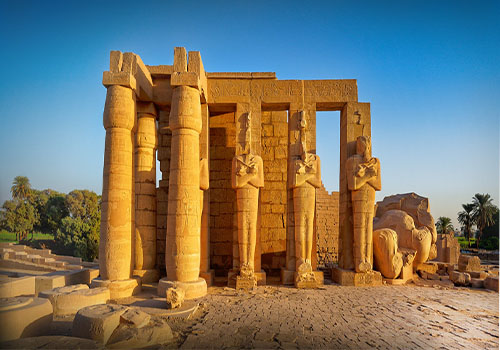
A Private tour to the Monastery of the town (Deir el Madina) and Temple of Ramses III with its huge Columns and Magnificent Scenes is Waiting for you.
We will be glad to pick you from your hotel to visit Deir el Medina not far from the Valley of the Kings and Valley of the Queens, the great tombs of the Pharaohs who lived in this village are painted inside with amazing scenes in vivid colours and are very impressive. Also on the site is a small Ptolemaic temple which has a lot of well preserved art, much of it still painted in the original colours. Then continue to Medinet Habu, in Arabic the "City of Habu". Its holy ground was believed to be where the Ogdoad, the four pairs of first primeval gods, were buried. Medinet Habu was both a temple and a complex of temples dating from the New Kingdom. It adjoins the cultivation at the southern end of the Theban necropolis; the area was one of the earliest places within the Theban region to be associated with the worship of Amun. Hatshepsut and Tutmosis III built a small temple to Amun on the site of an earlier structure next to their temple Ramesses III built his mortuary temple. The city is the most conspicuous standing monument. After that you will visit Ramesseum Temple (Ramses II temple). This temple was constructed to serve two purposes. The temple was publicly constructed to enable the ancient Egyptians to practice their religious rituals, including prayer and ritual offerings to the gods. It was also, and perhaps more so, built to demonstrate the greatness of the Pharaoh and his political and military achievements.The Ramesseum Temple complex also used to include a smaller temple dedicated to the mother of Ramses II, Tuya, and his wife Nefertari. After that you will be escorted back to your hotel.
We will be glad to pick you from your hotel to visit Deir el Medina not far from the Valley of the Kings and Valley of the Queens, the great tombs of the Pharaohs who lived in this village are painted inside with amazing scenes in vivid colours and are very impressive. Also on the site is a small Ptolemaic temple which has a lot of well preserved art, much of it still painted in the original colours. Then continue to Medinet Habu, in Arabic the "City of Habu". Its holy ground was believed to be where the Ogdoad, the four pairs of first primeval gods, were buried. Medinet Habu was both a temple and a complex of temples dating from the New Kingdom. It adjoins the cultivation at the southern end of the Theban necropolis; the area was one of the earliest places within the Theban region to be associated with the worship of Amun. Hatshepsut and Tutmosis III built a small temple to Amun on the site of an earlier structure next to their temple Ramesses III built his mortuary temple. The city is the most conspicuous standing monument. After that you will visit Ramesseum Temple (Ramses II temple). This temple was constructed to serve two purposes. The temple was publicly constructed to enable the ancient Egyptians to practice their religious rituals, including prayer and ritual offerings to the gods. It was also, and perhaps more so, built to demonstrate the greatness of the Pharaoh and his political and military achievements.The Ramesseum Temple complex also used to include a smaller temple dedicated to the mother of Ramses II, Tuya, and his wife Nefertari. After that you will be escorted back to your hotel. After that you will be escorted back to your hotel.
Rates are quoted Per person in USD$ as follows:
01 Person ( Solo Traveller) = 80$
From 02 to 03 People = 70$
From 04 to 6 People = 60$
Child from (6 to 11.99 Years Old) = 40$
Child under 6 years Old = Free